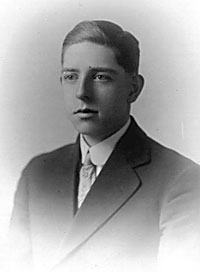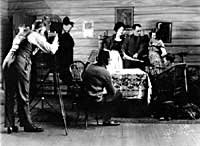Canada's First Amateur Feature-Length Film: A Race for Ties
Order...
The Lady Lumberjack: An Annotated Collection of Dorothea Mitchell's Writings
and
The Port Arthur Cinema Society Collection DVD.
 |
The following is a transcript of an interview conducted in 1963 by Harold Harcourt with Dorothea Mitchell describing her experience making A Race for Ties.
A RACE FOR TIES
(Its Inception)
by Dorothea Mitchell
It all started when one man conceived the idea of attempting something that no one else (in his community, at any rate,) had thought of doing. Fred Cooper, a business friend of mine, purchased a 16mm amateur movie-camera – something of a novelty 35 years ago! – to accompany him and his wife on a trip to England. After their return, they naturally threw a big party and showed the results to friends and employees. From this came requests to give a public showing in aid of charity.
 Fred Cooper
[Photo courtesy Andy & Laura Carlson] |
However, feeling that his pictures were too personal, ,Cooper asked me, a bit of a camera fiend myself, (but of the still variety) if we could not make a picture. It transpired that many published movie scripts intended for amateur production were altogether too brief for fund-raising purposes. Then he proposed that I write a story. This was in mid-February 1929.
Well, I’d never studied scenario writing, tho’ I had read several articles on the subject in Movie magazines. I said I’d try. "the rough draft was ready in a week’s time. It was of the comedy-drama type, the plot based on an experience of my own when in the timber business some years previously – in the Lakehead District. The man we selected to direct, Harold Harcourt, had at one time lived in Hollywood, where he was technical advisor on Army matters, so he had at least watched directors at work.
We three - cameraman, director and I – formed the Amateur Cinema Society of Thunder Bay, calling a meeting for the 1st of March, to which prospective performers were invited, and of course enrolled as members, each paying a fee of $1 per month, to help with initial expenses. Because I had written the story, and knew the theatrical talent available, I had been permitted to select the cast. All were experienced with the exception of the crooked timber-dealer, Cheetum, (with apologies to Dickens), chosen for the occasion; and "Laddie." This dog was truly a find; one might almost call him a "natural" He had never seen any of us previously, yet behaved as though he belonged to any member of the cast to whom he was assigned. There were, of course a couple of instances where strategy was essential. Leaving the office building, with message tied to his collar, his boss says "Home!" For this realistic dash up the street, Laddie’s real owner (a lad of 17) whistled him from an un-seen doorway at a distance. The same tactics sparked his racing out on the country road.
 Photo courtesy Library and Archives Canada |
What never ceases to intrigue me, tho' is the sequel to his arriving (and scratching at the door) of the Attwood home, following his hectic race. This interior was taken weeks later, yet this must have been pure coincidence’ one can hardly call it canine "acting". And in this connection I might mention that owing to the unavoidable lapse of time between the taking of the in- and outdoor sequences, it was necessary to keep written tab of costume detail – particularly of men’s hats and ties! At the outset, I had no intention of myself taking a role, but could find no one willing to play Aunt Sarah. Looking back, I realize what colossal nerve we – a small group of complete amateurs – showed in attempting such a task. A great measure of its success was undoubtedly due to our cameraman, who – for exterior scenes – used no tripod, having constantly to make quick change of position in order to keep up with action. True, he sometimes lost part of a particularly humorous scene, because he himself was laughing! One in particular comes to mind. When Cheetum’s emissary, Watnot, (plus conglomeration of equipment) had succeeded, the first time, in mounting his borrowed steed, that animal simply turned and re-entered the barn – literally wiping everything off his back! Incidentally, I was unaware until we started shooting, that this man had never ridden a horse in his life, nor driven a car. This naturally entailed considerable skulduggery; another man crouched down manipulating the pedals when starting or stopping and while in motion driving the vehicle. But it all added to the fun!
As already mentioned, our initial meeting was on the 1st of March, and – since snow scenes were essential – shooting commenced on Sunday the 3rd. We left the city at 7:45 a.m. (hardly daylight) for locations from 5 to 20 miles distant, taking snack-lunches with us. Everyone being in profession or business, exteriors had to be done on Sundays. The most interesting aspect (to me) was the complete lack of rehearsal (there wasn’t time!) and no re-takes. We just did as we were told. Country dwellings lacked phones in those days, so we’d just knocked at a door and asked permission to use the exterior. In one instance I’d known the family for years, the two small boys always calling me Auntie Mitchell. They at first resolutely refused, on account of my black wig, to believe it was I. Later, after attending the matinee at the Theatre, I became "Aunt Sarah" – and so remain to this day, not only to them, but to their joint aggregate of nine youngsters.
Exteriors were completed on the third Sunday (17th) – and none too soon, as snow had to be shovelled onto bare spots, and the mid-day meal skipped. At dusk, we trekked across a frozen lake (covered by nearly 3ft. of snow) to a summer cottage owned by one of the gang where we lighted stoves and had a much appreciated meal.
Neither had any of us the foggiest notion how long the completed story would run. We just kept going. (The ultimate was 1600ft. Directly after a roll was exposed, it had to go east to be processed and on its return the cameraman, director and I would congregate in my office (evenings of course), run it through a projector and cut it up. As Secretary Treasurer (and a few other odd jobs for good measure). I kept a record of every clipping, placing each in numbered section of egg-boxes – I’d dozens of them! – until interiors were taken and could be inserted in appropriate spots. Yes, there was ample unseen work, as well as fun. It may interest modern amateur-movie makers to know that projectors at that time were treacherous creatures! If stopped while the lamp was "on," the film scorched – naturally adding to the ticklishness of the constant reviewing necessary.
Then came interiors, for which a large box-type camera, with tripod, was acquired. The majority of these scenes were in the Atwood home. For these, the local photographers, from whom we bought our supplies, allowed us to use of one of their studios. Our Art man (who designed the credit-titles) covered walls with canvas, on which he simulated hewed logs. Quite realistic, too! Then our Transport man rustled up and installed suitable furniture.
(I’ve never been able to understand). Rather a pity, as it depicted timber-cutting operations, during which "the Goof" was knocked down by a falling tree.
After the interiors were finished and processed, came the task of cutting and egg-boxing them, preparatory to the no mean job of co-ordinating and splicing them to form the complete narrative. We elected a subtitle committee. The inserting of these was quite the most tricky work of all – deciding on the exact spot for each, with all the cutting and re-splicing this entailed.
My tentative title had been THE GIRL AND THE TIMBER LOST. But we decided that every member of the Society be asked for suggestions, and the one chose, A RACE FOR TIES, was little Jack’s idea.
Now for a few of its "lacks" It was recently brought to my notice that "the Goof" apparently dropped from the skies – which is perfectly true. Aunt Sarah, in planning to make this trip to Barlow’s had told the young people she hoped that God would show her the shortcut. But- there is no sub-title stating this.
There are other faults that I, myself, discern. In at least two instances, action is over-prolonged. The scene where Jack is ridiculing his sister’s dainty table manners, definitely drags. Where the camp foreman picks up Marion after her mock-faint, a cut is very much in order. Then, in reverse, Aunt Sarah’s movements in donning her snowshoes are much too rapid. The screen we originally purchased was not very satisfactory, so we had one made – 8’X10’ – and silvered.
When all was complete, we held a preview at the Prince Arthur Hotel (to which all the local VIPs were invited) on the 28th of May. The opinion we most appreciated, was that expressed by the Manager of the Paramount Theatre; he said our effort was "definitely ahead of many of the early professional productions, that it was, at all times, consistent and the continuity excellent."
The opening night at the Theatre was the 31st, exactly three months after the inception of the idea; we filled it three nights in succession. Later, the picture was shown, to benefit charities, in the surrounding towns and villages. Following all this excitement, we decided to have a day’s outing at one of the inland lakes, and do a short humorous picture. For this, I merely adapted a story, calling it SLEEP INN BEAUTY. A number of "extras" were included (over 60) posing as guests of the resort and taking part in a bathing beauty contest. Unfortunately photography was considerably marred by smoke from surrounding bush fires.
These accomplishments made our little Cinema Society ambitious. An office was rented and more equipment purchased. Nothing would satisfy but a crime story. New members were enrolled to suit the characters.
Everything went well until photography was completed but not the titling! (I felt rather proud of obtaining permission from on or our Bank Managers to use the premises for the safe cracking act). When the excitement and fun were over, interest lagged; members dropped out, and we accumulated a fairly sizable Bank debt. It ended in my buying the equipment and films in order to liquidate this indebtedness. Thus, our third production, THE FATAL FLOWER, excellent as to camera work, remains unfinished.
|